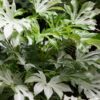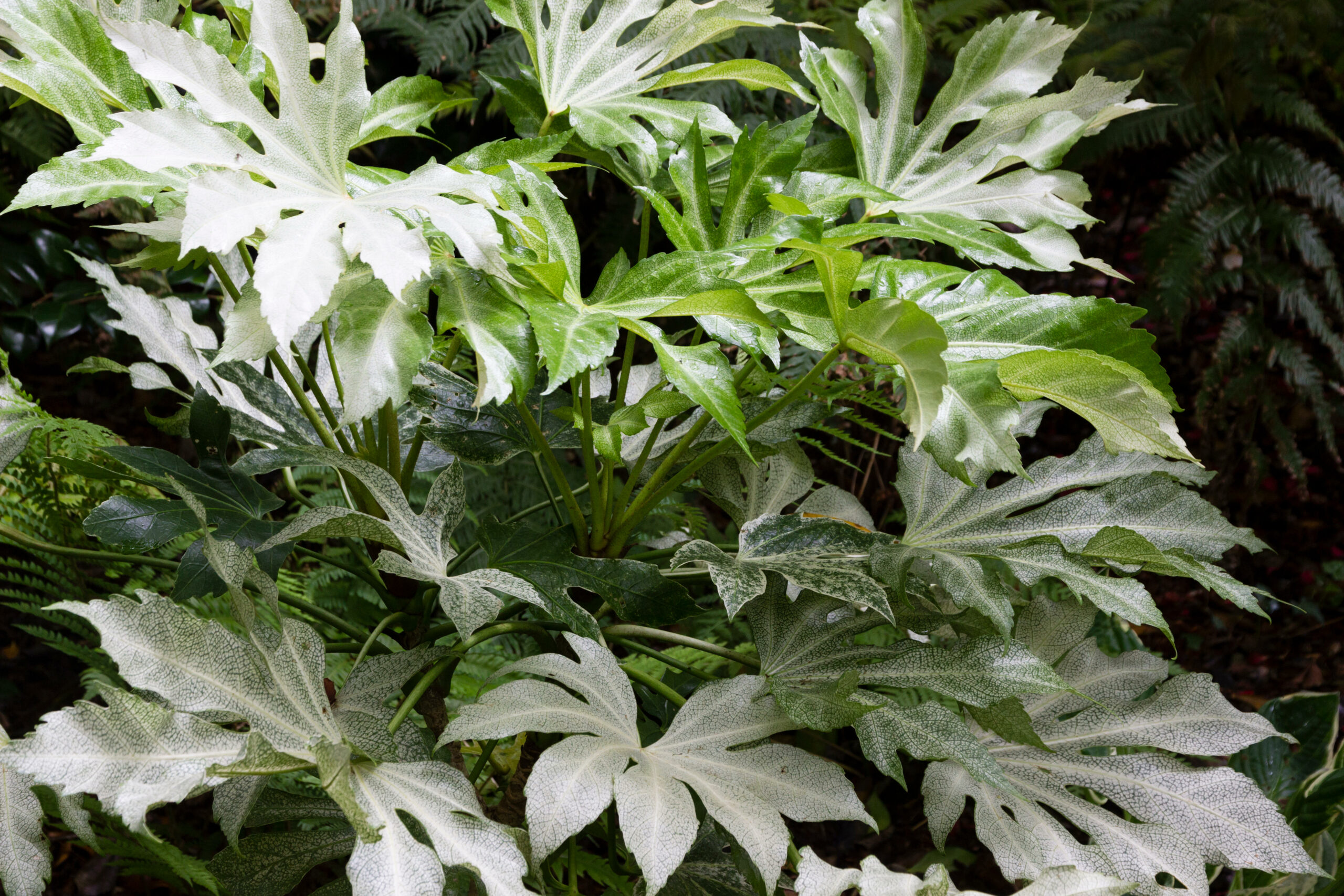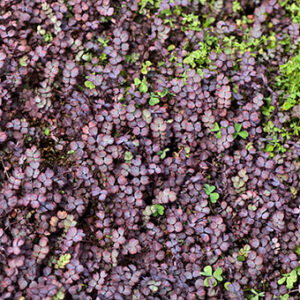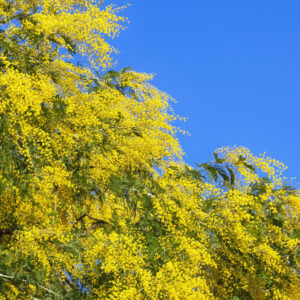Fatsia japonica ‘Spiders Web’
Price range: £20.00 through £45.00
Frequently Bought Together



Description
Quick Facts
- Common Name: Spider’s Web Japanese Aralia, Variegated Fatsia, Paper Plant
- Botanical Name: Fatsia japonica ‘Spider’s Web’
- Plant Type: Evergreen shrub
- Mature Height: 1.2-1.8m
- Mature Spread: 1.2-1.5m
- Flowering Period: October to November
- Flower Colour: Creamy-white spherical clusters
- Foliage: Large, glossy, palmate leaves heavily splashed with white variegation
- Hardiness: RHS H4 (hardy in most of UK and Ireland, may need protection in severe winters)
- Soil Requirements: Moist, well-drained, fertile soil; tolerates most soil types
- Aspect: Partial shade to full shade; sheltered position essential
- Maintenance: Low to moderate
Description
Experience the breathtaking beauty of Fatsia japonica ‘Spider’s Web’, the most dramatically variegated evergreen shrub for gardens, where each magnificent hand-shaped leaf is adorned with intricate white splashes and speckles resembling delicate spider webs glistening with morning dew, bringing exceptional luminosity and exotic drama to shaded spaces. This extraordinary cultivar offers remarkable qualities—bold palmate foliage measuring up to 35cm across heavily marked with pure white variegation creating luminous architectural impact and bringing brilliant light to the darkest corners, each leaf uniquely patterned with irregular white splashes, spots, and streaks ensuring no two are identical like nature’s own artwork, glossy evergreen leaves providing year-round structure and exceptional brightness in shade where few other variegated plants succeed, creamy-white spherical flower clusters in autumn adding seasonal interest and attracting late-season pollinators followed by black berries for wildlife, and exceptional shade tolerance thriving in deep shade where most heavily variegated plants struggle or revert to green, making this one of the most spectacular choices for adding exotic drama, luminous variegation, and architectural presence to shaded gardens, sheltered courtyards, and urban spaces where its striking foliage creates unforgettable impact and transforms dark areas into illuminated features.
Throughout the seasons, this captivating shrub displays its characteristic large palmate leaves—each leaf divided into 7-9 deeply lobed fingers radiating from central point like an elegant hand, creating bold architectural silhouette. ‘Spider’s Web’ is renowned as one of the most heavily variegated Fatsia cultivars—leaves emerge dramatically splashed and speckled with pure white markings scattered across the deep green background in irregular patterns that truly resemble intricate spider webs caught with morning dew, with some leaves displaying more white than green creating almost ghostly appearance. The variegation is stable and consistent, with each new leaf emerging beautifully marked. The glossy leaf surface reflects available light magnificently, making the white variegation incredibly luminous and eye-catching even in deep shade—this plant literally glows in shaded positions where darker plants would disappear into shadow. In autumn (October-November), mature plants produce rounded clusters of small creamy-white flowers held on branching stems above the foliage—these spherical umbels create architectural interest and attract late-season pollinators including bees. Following flowering, small black berries develop providing food for birds through winter months. The overall effect is exotic, tropical, and dramatically luminous—like having a piece of illuminated jungle paradise in your garden. The heavily variegated foliage creates stunning contrast against darker green plants and brings exceptional brightness to shaded areas where colour and light are precious commodities.
Native to the coastal woodlands of Japan and South Korea where it grows naturally in sheltered, shaded forest understoreys, Fatsia japonica has been cultivated in Western gardens since the Victorian era and is beloved for its exotic appearance and exceptional shade tolerance. The genus name Fatsia is derived from the Japanese word ‘fatsi’ meaning eight, referring to the typically eight-lobed leaves (though 7-9 lobes are common). The cultivar ‘Spider’s Web’ was selected and introduced by Japanese nurseries specifically for its exceptional heavy variegation and stable white markings that resemble intricate spider webs—the name perfectly captures the delicate white splashes scattered across each leaf. This cultivar is more compact than plain green forms with moderate growth rate, adding 15-25cm annually once established. Hardy to RHS H4, this shrub tolerates winters reliably in most areas, though the heavily variegated foliage is more tender than plain green forms—young plants and new growth benefit from fleece protection during severe frosts or in exposed positions, and established plants require sheltered positions away from cold winds and hard frosts. Particularly valuable for its exceptional shade tolerance combined with heavy variegation—this is one of the few heavily variegated evergreen shrubs that thrives in deep shade where most variegated plants struggle or revert to green. Also tolerates urban pollution and coastal conditions (in very sheltered positions). The evergreen foliage provides year-round structure and screening with exceptional luminosity. Outstanding in containers for patios, courtyards, and sheltered balconies where its exotic variegated appearance creates instant tropical drama and brings light to shaded spaces.
Create stunning compositions by planting as bold luminous focal point in shaded borders where its dramatically variegated foliage draws the eye and illuminates the darkest corners like a natural spotlight, positioning in sheltered courtyards or against north-facing walls where its shade tolerance excels and shelter protects tender variegated foliage, or using in urban gardens and basement areas where its brilliant white variegation brings precious light to gloomy spaces. Exceptional in woodland-style gardens combined with dark-leaved ferns (Dryopteris affinis, Polystichum setiferum), hostas with blue or dark green foliage, and hellebores for dramatic contrast that emphasizes the white variegation, Japanese-inspired gardens paired with black bamboos (Phyllostachys nigra), dark-leaved acers, and evergreen azaleas for authentic oriental aesthetic with striking contrast, or contemporary minimalist gardens where its bold architectural form and luminous variegation provides dramatic focal point against dark walls or paving. Works beautifully planted as single specimen where each plant can be appreciated individually, in generous containers (minimum 50cm diameter) for patios and entrance areas where its exotic variegated foliage creates welcoming statement and brings light to shaded doorways, or combined with dark purple or black foliage plants like Ophiopogon planiscapus ‘Nigrescens’, dark heucheras (‘Obsidian’, ‘Black Pearl’), or Ajuga reptans ‘Black Scallop’ where the white variegation creates maximum dramatic contrast. Also magnificent with lime-green or golden foliage plants like Hakonechloa macra ‘Aureola’ or Carex oshimensis ‘Evergold’ for luminous shade combinations that glow even on dullest days. Perfect for adding exotic drama, exceptional luminous variegation, and architectural presence to shaded gardens, sheltered courtyards, and urban spaces where its brilliant foliage transforms dark areas into illuminated garden features.
Caragh Garden Notebook
Planting: Space shrubs 1.2-1.5m apart for individual specimens. Plant container-grown specimens year-round, though spring (March-May) or early autumn (September) is ideal for best establishment, avoiding late autumn/winter planting which exposes tender variegated growth to frost damage. Choose very sheltered position in partial to full shade—avoid hot, sunny positions which severely scorch the white variegated foliage causing extensive leaf burn and browning. Tolerates deep shade exceptionally well—one of the best heavily variegated plants for shade. Requires excellent shelter from cold winds and hard frosts which can severely damage the tender white-marked foliage—ideal positions include sheltered courtyards surrounded by walls or buildings, north or east-facing walls with overhead protection, beneath tree canopies in urban gardens, or any position with maximum shelter and protection. Dig generous planting hole twice width of root ball and same depth. Incorporate plenty of organic matter (well-rotted compost, leaf mould) to improve moisture retention and fertility. Plant at same depth as in container—avoid planting too deeply. Water thoroughly after planting and apply 5-8cm mulch of organic matter around base, keeping mulch clear of main stems. Stake young plants in exposed positions until established. Consider planting in spring rather than autumn in colder areas to allow full growing season for establishment before first winter. Position where the luminous variegated foliage can be viewed and appreciated, particularly in areas that need brightening.
Soil Preparation: Tolerates wide range of soil types including clay, loam, and sandy soils, but performs best in moist, well-drained, fertile soil enriched with organic matter. Prefers neutral to slightly acidic pH (6.0-7.0) but tolerates slightly alkaline conditions. Requires consistent moisture—avoid dry soils which cause leaf drop and poor growth, particularly damaging to variegated foliage. Improve heavy clay soils by incorporating grit and organic matter to improve drainage. Improve light sandy soils by adding generous amounts of compost or well-rotted manure to improve moisture retention—consistent moisture is especially important for heavily variegated forms. Mulch annually in spring with 5-8cm layer of organic matter (compost, leaf mould, well-rotted manure) to conserve moisture, suppress weeds, and improve soil fertility. Keep mulch clear of stems to prevent rot. Best growth and variegation occur in sheltered shade with moist, well-drained soil enriched with organic matter and consistent moisture.
Container Growing: Outstanding in large containers (minimum 50cm diameter and depth) for patios, courtyards, and sheltered balconies—container growing allows you to position this tender variegated form in the most sheltered spots and move to maximum protection in winter. Use soil-based compost (John Innes No. 3) mixed with additional organic matter for moisture retention and stability. Ensure containers have adequate drainage holes. Position in very sheltered, shaded location—avoid hot sunny spots (which scorch variegated foliage) and exposed windy positions (which damage tender leaves). Water regularly during growing season to keep compost consistently moist but not waterlogged—container-grown plants dry out faster than those in ground, and consistent moisture is crucial for healthy variegation. Feed monthly April-September with balanced liquid fertiliser or apply slow-release fertiliser in spring to promote vigorous growth and strong variegation. Move containers to most sheltered position during winter (against house walls, in porches, or even into unheated conservatories during severe cold spells) or wrap pots with bubble wrap and protect foliage with fleece during hard frosts. Top-dress annually in spring by removing top 5-8cm of compost and replacing with fresh compost mixed with slow-release fertiliser. Repot every 3-4 years in spring into slightly larger container, or root-prune and return to same pot.
Seasonal Care: Requires minimal pruning—the naturally bushy form develops without intervention. Prune lightly in spring (March-April) if needed to control size or improve shape—Fatsia tolerates hard pruning if plant becomes too large, cutting back to 30-60cm from ground will regenerate new growth (though this sacrifices one season’s display). CRITICAL: Remove any plain green (reverted) shoots immediately as soon as they appear—these lack variegation and are significantly more vigorous than variegated growth, eventually overwhelming and replacing the desirable white-marked foliage if left unchecked. Cut reverted shoots back to point of origin or below soil level if arising from base. Regular monitoring and prompt removal of reverted growth is essential to maintain the spectacular variegation. Remove any damaged, diseased, or frost-damaged leaves in spring to maintain appearance—variegated foliage is more prone to frost damage than green forms. Apply general-purpose balanced fertiliser or blood, fish and bone in spring to promote healthy vigorous growth and strong variegation. Mulch annually in spring. Water regularly during dry spells, particularly spring and summer, to maintain consistent soil moisture—established plants tolerate brief dry periods but prolonged drought causes leaf drop, particularly damaging to variegated forms. Protect young plants and new growth during severe frosts (below -5°C) with horticultural fleece or move containers to sheltered position—variegated forms are more tender than green forms and require more winter protection. Watch for aphids on new growth (spray with water or insecticidal soap) and scale insects on stems (remove by hand or treat with horticultural oil). Generally pest and disease free with proper positioning and care. The variegation is reliably spectacular and luminous!
Propagation: Can be propagated from semi-ripe cuttings taken in late summer (July-August), selecting shoots with good variegation. Take 10-15cm cuttings from current season’s growth, remove lower leaves, dip in rooting hormone, and insert into pots filled with free-draining compost (50:50 compost and perlite or sharp sand). Keep in sheltered, shaded position and maintain humidity with plastic bag or propagator. Rooting takes 6-8 weeks. Pot on individually once rooted and grow on for full season before planting out. Note that variegation may be variable in cuttings—select parent material with strong, stable variegation. Can also be propagated from seed, though variegation will NOT come true from seed and seedlings will revert to plain green—vegetative propagation (cuttings) is essential to maintain the ‘Spider’s Web’ variegation. Division is not practical due to woody growth habit. Home gardeners can propagate this cultivar, though nursery-grown specimens provide more immediate impact and guaranteed variegation quality.
This spectacular beauty is absolutely breathtaking—one of the most heavily variegated evergreens available! Those intricate white splashes and speckles covering each magnificent hand-shaped leaf (up to 35cm across!) are absolutely stunning—resembling delicate spider webs glistening with morning dew! Each leaf uniquely patterned with irregular white markings ensuring no two are identical, glossy surface reflecting light magnificently making the variegation incredibly luminous even in deep shade—this plant literally glows where darker plants disappear! Bold architectural palmate foliage divided into 7-9 lobed fingers, creamy-white spherical flower clusters in autumn, year-round evergreen structure. Exceptional shade tolerance—thrives in deep shade where most variegated plants fail. CRITICAL: requires excellent shelter from cold winds and frosts—variegated foliage is tender, so choose sheltered courtyards, north-facing walls, or positions with maximum protection. Remove any plain green reverted shoots immediately to maintain spectacular variegation. Perfect for shaded gardens, sheltered courtyards, urban spaces, and anywhere you want to transform dark corners into illuminated features with exotic drama and luminous variegation. Pure exotic magnificence and architectural brilliance!
Additional information
| Pot Size |
|---|






